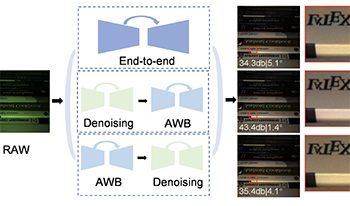
In modern image signal processors (ISPs), many modules have adopted deep neural networks (DNNs). This study explores whether a single DNN can effectively replace both the auto white balance (AWB) and denoising modules, or if they should be processed separately. Our experiment results suggest that performing AWB and denoising individually can produce better performance than an end-to-end approach. Moreover, processing denoising before AWB leads to a significant improvement, with an increase of nearly 6 dB in PSNR and 30% reduction in mean angular error (MAE). These findings suggest that careful consideration of the processing order in ISP pipelines can lead to substantial enhancements in image quality.
Shuwei Yue, Minchen Wei, "Exploring the Efficiency of End-to-end vs. Separate Sequencing of DNN-based AWB and Denoising In-camera Processing Pipeline" in Color and Imaging Conference, 2024, pp 80 - 83, https://doi.org/10.2352/CIC.2024.32.1.16
 Find this author on Google Scholar
Find this author on Google Scholar Find this author on PubMed
Find this author on PubMed